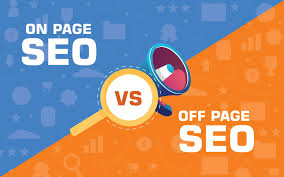 Digital Marketing
Digital Marketing
On-Page vs. Off-Page SEO Techniques: 7 Critical Differences Every…
If you’ve ever wondered why some websites effortlessly climb to the top of Google while others struggle despite great content, the answer often lies in mastering both on-page and off-page SEO techniques. In today’s highly competitive digital landscape, understanding and applying these strategies is no longer optional — it’s essential. Whether you’re a blogger, a small business owner, or someone pursuing a Digital Marketing Course Online, knowing the difference between on-page and off-page SEO could be the game-changer that propels your website ahead of the pack.
In this comprehensive guide, we’ll explore the On-Page vs. Off-Page SEO Techniques that matter most in 2025, what sets them apart, and how you can leverage both for long-term success.
What is On-Page SEO?
On-page SEO refers to all the actions you take within your website to optimize it for search engines and users. These are the elements you can directly control and improve to make your site more accessible, faster, and more relevant to search queries. At its core, on-page SEO ensures that your website’s structure, code, and content align with search engine guidelines and user intent.
Some crucial on-page factors include:
-
High-quality, keyword-optimized content that addresses the target audience’s questions.
-
HTML elements like title tags, meta descriptions, header tags, and image alt attributes.
-
Internal linking strategies that help distribute link equity and guide users through the site.
-
URL structure that is clean, descriptive, and SEO-friendly.
-
Page speed, mobile responsiveness, and secure protocols (HTTPS).
When done right, on-page SEO helps search engines better understand your content, leading to higher visibility in search engine result pages (SERPs).
What is Off-Page SEO?
In contrast, off-page SEO refers to all the efforts you make outside of your website to impact your rankings. The primary goal is to build your site’s authority, trustworthiness, and relevance by securing backlinks and establishing a robust digital presence.
Off-page SEO techniques revolve around:
-
Earning high-quality backlinks from authoritative websites.
-
Social media marketing to amplify your content’s reach.
-
Guest posting and digital PR to position your brand as a thought leader.
-
Influencer collaborations that boost credibility.
-
Online reviews and citations that enhance local SEO.
Unlike on-page SEO, these factors are not entirely in your control, but they play a significant role in how search engines assess the value and reliability of your website.
On-Page vs. Off-Page SEO Techniques: The Key Differences
Both on-page and off-page SEO techniques are critical to a balanced SEO strategy, but they address different aspects of search engine optimization. On-page SEO focuses on optimizing elements within your website, ensuring that the content is valuable, the structure is sound, and the user experience is seamless. On the other hand, off-page SEO works to enhance your site’s reputation and authority by earning external validation in the form of backlinks, mentions, and shares.
For example, writing a detailed, well-structured blog post with optimized meta tags and schema markup is on-page SEO at work. Meanwhile, promoting that blog post through partnerships, social media, and outreach efforts falls under off-page SEO. Both strategies complement each other. Without strong on-page SEO, off-page efforts may drive traffic that quickly bounces, harming your rankings. Conversely, without off-page SEO, even the most optimized site may struggle to climb in SERPs due to low authority.
The Importance of Balancing Both Techniques
Many website owners fall into the trap of focusing on one at the expense of the other. It’s easy to overemphasize off-page SEO, especially backlink building, because of its visible impact on domain authority scores. However, without solid on-page SEO, those backlinks won’t deliver sustainable results. A page that loads slowly, has thin content, or lacks mobile optimization will repel users, no matter how many links point to it.
Similarly, a website with stellar on-page SEO but no external endorsements will struggle to rank against more established competitors. Search engines see backlinks as votes of confidence. A site that lacks these external signals appears less trustworthy, no matter how good the internal optimization is.
The most successful SEO strategies in 2025 combine both on-page and off-page efforts. Brands that achieve this balance often dominate their niches because they cater to both search engine algorithms and real human users.
Latest Trends Shaping On-Page and Off-Page SEO
SEO is never static, and both on-page and off-page techniques evolve as search engines refine their algorithms. In terms of on-page SEO, Google’s emphasis on helpful content and user experience means that quality writing, original research, and multimedia integration are more important than ever. Additionally, Core Web Vitals — which measure loading performance, interactivity, and visual stability — have become ranking signals you can’t ignore.
Meanwhile, off-page SEO has shifted from quantity to quality. Gone are the days when mass link-building through directories or low-quality blogs worked. Today, editorial links from respected publications, earned media, and mentions from industry influencers provide the best results. Social signals, while not direct ranking factors, increasingly influence how content gets discovered and shared.
A practical example is seen in brands that produce long-form guides or reports (on-page SEO) and then amplify them through webinars, influencer shoutouts, or partnerships with educational platforms (off-page SEO). Many marketers enrolled in a Digital Marketing Course Online are taught to blend these techniques effectively for holistic SEO performance.
How to Craft a Strategy Combining On-Page and Off-Page SEO
Creating an SEO plan that works means prioritizing tasks across both on-page and off-page domains. Start with a technical audit of your website to fix errors that may hinder on-page SEO: broken links, slow pages, missing alt tags, or duplicate content. Then move on to producing high-quality, intent-matching content that answers the questions your audience is asking.
Once your on-page foundation is solid, turn your attention to off-page initiatives. Reach out for guest post opportunities, build relationships with industry bloggers, and engage authentically on social media platforms where your target audience spends time. Make it easy for others to link to your content by offering value — original data, unique insights, or useful tools.
Measurement is key. Use analytics tools to track not only traffic and rankings but also engagement metrics like time on site, bounce rates, and conversions. If you notice that your pages attract visitors but don’t convert, revisit your on-page elements. If traffic growth is stagnant, it might be time to refresh your off-page efforts.
Conclusion: Why Both Techniques Are Essential for Success
In the ongoing debate of On-Page vs. Off-Page SEO Techniques, the clear winner is neither. The real victory lies in integrating both approaches into a unified strategy that serves users and satisfies search engines. In 2025, SEO success is about synergy — combining technical precision, content excellence, and authority-building practices into one seamless experience.
By mastering both on-page and off-page SEO, you not only increase your visibility but also build lasting credibility and trust with your audience. Whether you’re learning independently or through a Digital Marketing Course Online, applying these insights will position you for long-term digital success.
Search engines are smarter, and competition is fiercer. The brands that thrive will be those that balance internal optimization with external validation — and do so consistently. Now is the time to review your SEO approach and ensure that both sides of the equation work together to drive your growth.






